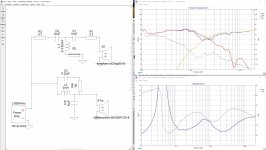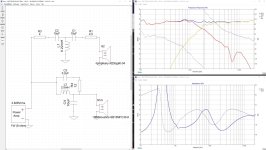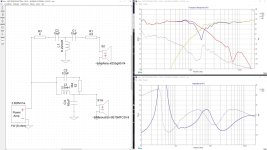WOW, thanks
I put "-0.5 [in]" into "mod delay" for the SB15MFC30 in XSim, since the acoustic center is behind the tweeter I figure it should be a negative value.
If I input X and Y scale values in FP Trace my "mod sensitivity" for both drivers is "0".
I put "-0.5 [in]" into "mod delay" for the SB15MFC30 in XSim, since the acoustic center is behind the tweeter I figure it should be a negative value.
If I input X and Y scale values in FP Trace my "mod sensitivity" for both drivers is "0".
I've been rereading about mod offset and I guess woofer mod offset is a positive number when it's behind the tweeter.
Is this correct?
"mod offset" on the SB15MFC30 is set to 0.6 inches or 15.24 mm.
But the FR graphs looks even better at 25.4 mm offset.
Cross-over acceptable?
I really did not want to use 100 uF caps in this cross-over, even electrolytic caps, which I have and I have 4 giant 51 uF caps also.
Is this correct?
"mod offset" on the SB15MFC30 is set to 0.6 inches or 15.24 mm.
But the FR graphs looks even better at 25.4 mm offset.
Cross-over acceptable?
I really did not want to use 100 uF caps in this cross-over, even electrolytic caps, which I have and I have 4 giant 51 uF caps also.
Attachments
You can use 2 * 51uF caps in parallel for the 100uF impedance compensation cap used in the XT25 circuit. It won't affect sound quality at all using these here
Don't change the mod offset to make the crossover look good. Change the crossover to make it work for the actual mod offset
Don't change the mod offset to make the crossover look good. Change the crossover to make it work for the actual mod offset
Your latest crossover does not have good phase tracking
The XT25 is playing 5dB higher than mine down low. This may or may not be a problem
Zaph recommends an impedance resonance circuit on the XT are you going to allow for one? You can always add it later
Your target system sensitivity should be about 84dB I think. Your xt level might be 1 or 2 dB too low. This may be acceptable on the room or make it sound dull. Hard to tell
Have you tried using Mr FRD data?
The XT25 is playing 5dB higher than mine down low. This may or may not be a problem
Zaph recommends an impedance resonance circuit on the XT are you going to allow for one? You can always add it later
Your target system sensitivity should be about 84dB I think. Your xt level might be 1 or 2 dB too low. This may be acceptable on the room or make it sound dull. Hard to tell
Have you tried using Mr FRD data?
Here is my final cross-over that I already have on x-over boards and just have to solder it together, BUT I CAN CHANGE IT.
Phase tracking? The tweeter is 18 db and woofer is 12 db. It's not going to have a nice reverse null.
Guess I wasn't paying attention to the phase tracking at all and don't know what it should look like anyway.
It's the other line on the FR graph, no?
I DO NOT LIKE TWEETERS. I LIKE VERY TIGHT BASS.
I'm always turning down highs and turning up bass, my father is the same way. I'm not sure why.
A lot of "audiophile" speakers are my worst nightmare.
OKAY, so the attached images suck then?
Phase tracking? The tweeter is 18 db and woofer is 12 db. It's not going to have a nice reverse null.
Guess I wasn't paying attention to the phase tracking at all and don't know what it should look like anyway.
It's the other line on the FR graph, no?
I DO NOT LIKE TWEETERS. I LIKE VERY TIGHT BASS.
I'm always turning down highs and turning up bass, my father is the same way. I'm not sure why.
A lot of "audiophile" speakers are my worst nightmare.
OKAY, so the attached images suck then?
Attachments
Mixed or asymmetric slopes (where a tweeter or woofer slopes more than the other) is how we get phase alignment when voice coils are not on the same Z axis (i.e. flat baffle, woofer behind tweeter). If you had symmetrical slopes AND got good phase tracking on a flat baffle, I would say you have something wrong 🙂 (excluding ladder delay networks and DSP).
Your latest version looks a lot better. You can see a bigger reverse null "V" forming when you flip the polarity. You are now getting better phase tracking.
A trick to tweak any slope, is to add a resistor in series to parallel legs of crossover. ie. add a series resistor to C4 or L1 - depending which driver you want to pull the response up on (i.e. lessen the slope). Doing this on one or other (not both) will allow you to shape the order. It's worth a try to improve phase tracking. You can see I did this on post #38 in my crossover where I added a 1 ohm resistor to the parallel inductor on the woofer (sorry I didn't name components).
Your latest version looks a lot better. You can see a bigger reverse null "V" forming when you flip the polarity. You are now getting better phase tracking.
A trick to tweak any slope, is to add a resistor in series to parallel legs of crossover. ie. add a series resistor to C4 or L1 - depending which driver you want to pull the response up on (i.e. lessen the slope). Doing this on one or other (not both) will allow you to shape the order. It's worth a try to improve phase tracking. You can see I did this on post #38 in my crossover where I added a 1 ohm resistor to the parallel inductor on the woofer (sorry I didn't name components).
Have you temporarily wired up the above crossover for a listen? Worth doing before you solder / lock everything in place. It's ok to run one speaker - if you can set your source to mono to get a feel for it across diverse music.
Yeah I figure I could try it.
The tweeter plays at 50 db at 582 Hz vs the SB15 is at 82.7 db at 582Hz.
I guess I wasn't sure what "ringing" was.
Maybe the answer could be in the CSD, if it goes that low.
No, waterfall looks good at 582 Hz.
Vifa XT25BG60-04 does have a lot of HD distortion around 500-580 Hz, but not nearly as much as the XT25TG30-04.
https://hificompass.com/en/speakers/measurements/vifa/vifa-xt25tg30-04
https://hificompass.com/en/speakers/measurements/vifa/vifa-xt25bg60-04
The the XT25TG30-04 has off the chart HD distortion at 500-580 Hz (Fs), literally.
I have to put the BG60 at 8v, almost, to get it to distortion as much as the TG30 at 2v.
The tweeter plays at 50 db at 582 Hz vs the SB15 is at 82.7 db at 582Hz.
I guess I wasn't sure what "ringing" was.
Maybe the answer could be in the CSD, if it goes that low.
No, waterfall looks good at 582 Hz.
Vifa XT25BG60-04 does have a lot of HD distortion around 500-580 Hz, but not nearly as much as the XT25TG30-04.
https://hificompass.com/en/speakers/measurements/vifa/vifa-xt25tg30-04
https://hificompass.com/en/speakers/measurements/vifa/vifa-xt25bg60-04
The the XT25TG30-04 has off the chart HD distortion at 500-580 Hz (Fs), literally.
I have to put the BG60 at 8v, almost, to get it to distortion as much as the TG30 at 2v.
Got one speaker done more or less.
Tweeter sounds good, doesn't irritate me.
I build the box wrong about 5 years ago. The baffles I build rescently.
But the box hasn't cracked in 5 years.
There's a guy on youtube that build speakers correctly: John Heisz.
Cross-over is 18db electrical on tweeter and 12 db on the woofer, so I won't have a large reverse null, I think.
Also drivers are wired in phase, both positive terminals go to positive signal.
I didn't think there was much attenuation difference between 12db and 18db on the tweeter.
But I definitely didn't want that notch filter, so I went with it.
The SB26ADC-C000-4 measures real well; I wonder if I would like it as much as the XT25.
https://hificompass.com/en/speakers/measurements/sbacoustics/sb-acoustics-sb26adc-c000-4
The SB 26STAC sounded almost as good as the XT25 in the high end and I think the low end was better and more of it maybe.
Speaker looked better in satin polyurethane, but I ran out so gloss it was, but don't look too bad I guess.
Woofer has a nice poly "seat belt and suspenders" sound, as one diy member put it.
I wouldn't want to use the larger 6.5" though, I think.
I generally like metal or old Eton hex cones were almost.
But definitely sounds good.
Also in the pics is my old EQ.
I turned it off for while using the speakers for now.
Tweeter sounds good, doesn't irritate me.
I build the box wrong about 5 years ago. The baffles I build rescently.
But the box hasn't cracked in 5 years.
There's a guy on youtube that build speakers correctly: John Heisz.
Cross-over is 18db electrical on tweeter and 12 db on the woofer, so I won't have a large reverse null, I think.
Also drivers are wired in phase, both positive terminals go to positive signal.
I didn't think there was much attenuation difference between 12db and 18db on the tweeter.
But I definitely didn't want that notch filter, so I went with it.
The SB26ADC-C000-4 measures real well; I wonder if I would like it as much as the XT25.
https://hificompass.com/en/speakers/measurements/sbacoustics/sb-acoustics-sb26adc-c000-4
The SB 26STAC sounded almost as good as the XT25 in the high end and I think the low end was better and more of it maybe.
Speaker looked better in satin polyurethane, but I ran out so gloss it was, but don't look too bad I guess.
Woofer has a nice poly "seat belt and suspenders" sound, as one diy member put it.
I wouldn't want to use the larger 6.5" though, I think.
I generally like metal or old Eton hex cones were almost.
But definitely sounds good.
Also in the pics is my old EQ.
I turned it off for while using the speakers for now.
Attachments
-
 20230930_130044.jpg578 KB · Views: 73
20230930_130044.jpg578 KB · Views: 73 -
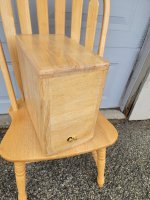 20230930_130040.jpg570 KB · Views: 54
20230930_130040.jpg570 KB · Views: 54 -
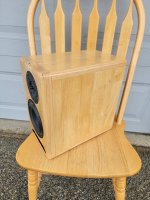 20230930_130033.jpg585.4 KB · Views: 66
20230930_130033.jpg585.4 KB · Views: 66 -
 20230930_130027.jpg495.9 KB · Views: 67
20230930_130027.jpg495.9 KB · Views: 67 -
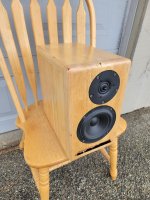 20230930_130022.jpg482.8 KB · Views: 70
20230930_130022.jpg482.8 KB · Views: 70 -
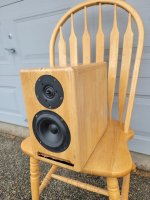 20230930_130015.jpg498.6 KB · Views: 62
20230930_130015.jpg498.6 KB · Views: 62 -
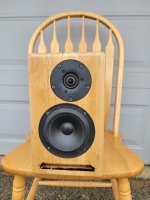 20230930_130013.jpg417.7 KB · Views: 74
20230930_130013.jpg417.7 KB · Views: 74 -
 20230930_130424.jpg642.1 KB · Views: 75
20230930_130424.jpg642.1 KB · Views: 75
Thanks for the help Dave Bullet and every one.
Mr. Bullet did the FRD files have baffle sizing and driver location inputted into them?
How did you do that? With XSIM?
I'm making a larger speakers and would like to input that info into them.
Sorry I opted for a steep slope instead of your LinkwitzRiley Crossover, 2ndOrder.
I really didn't want a large metal film, paper or poly (what are they called, the large caps?) cap in the notch or the electrolytics I found in the cross-over.
But your SB files and FRD/ZMA files and help was invaluable.
Although the extra 6db didn't seem to steepen the slope on the tweeter that much. Speakers sound good to me, even the port, but I'm not much of an "audiophile".
I just notice when bass is slow/boomy and the tweeters make a lot of shrill sounds and Ssss vocal noises.
My girlfriend told me once "you can't tell the difference between the speakers you built and TV speakers" and I thought: that's ridiculous.
Then I would be listening to my speakers for about 20 minutes thinking they sound great and then I realize I've been listening to the TV those whole 20 minutes.
Mr. Bullet did the FRD files have baffle sizing and driver location inputted into them?
How did you do that? With XSIM?
I'm making a larger speakers and would like to input that info into them.
Sorry I opted for a steep slope instead of your LinkwitzRiley Crossover, 2ndOrder.
I really didn't want a large metal film, paper or poly (what are they called, the large caps?) cap in the notch or the electrolytics I found in the cross-over.
But your SB files and FRD/ZMA files and help was invaluable.
Although the extra 6db didn't seem to steepen the slope on the tweeter that much. Speakers sound good to me, even the port, but I'm not much of an "audiophile".
I just notice when bass is slow/boomy and the tweeters make a lot of shrill sounds and Ssss vocal noises.
My girlfriend told me once "you can't tell the difference between the speakers you built and TV speakers" and I thought: that's ridiculous.
Then I would be listening to my speakers for about 20 minutes thinking they sound great and then I realize I've been listening to the TV those whole 20 minutes.
Hey Jimmy,
You're welcome. This is your speaker, so you are free to choose what you do. I'm not worried if people use my advice (it could be wrong after all!). I learn through the experience too.
I used VituixCAD which has an enclosure designer and baffle diffraction simulator. I then exported the FRD files of each of these. I previously generated IEC baffle and infinite baffle "box" response FRDs (which you can also do in VituixCAD).
In terms of combining - there was a group called "FRD Consortium" who created an old MS Office Excel spreadsheet called Frequency REsponse Combiner. I still have Excel2000 and it's an easy way to import all the curves needed and "add/subtract" them together. You could do this in REW one by one, but the Excel spreadsheet is a "one click" operation. The spreadsheet may work in Open Office or similar - but is heavy on macros and add-in use, so I think you'd probably need Excel. The website has long gone, but I can provide a copy of the spreadsheet and other FRD tools.
People think electrolytic caps are evil. I don't think so. Ok sure, I use Clarity Polycaps on my tweeters, but they are usually small value. Anything over ~ 12uF becomes a cheaper poly cap (e.g. Solen) or electrolytic. Anything > 80uF is definitely electrolytic, and I think the 100uF called for if you wanted to damp the XT25 resonance would be fine as a cheap electrolytic.
In terms of boominess, this could be a number of causes:
1. Wrong box/port tuning
2. Cabinet resonance
3. Placement
4. Incorrect bafflestep compensation (crossover design issue)
5. Accidental use of EQ / bass boost / loudness
A simple test is to use socks to stuff the port and turn it into a sealed box. See if that helps. Also bring the speakers out into the room a bit more. You can use tools like WinISD to generate a sine wave at any particular frequency and slowly move up and down to see if you get a number of "one note boom" problems. It may be evident in the room and not the speaker.
I've never used the XT25 (any variant) so I can't speak for its sibilance behaviour. Unless one particular version of the XT25 is good (or bad), I haven't read anything negative about the XT25, and Zaph used it in his reference ZD5 (although a different version).
The next best course of action might be to buy a measurement microphone and get some hard data to see what is going on. Apart from the cost, measurements are not that daunting. The issue is usually getting a place / space where you can see what is going on with the speaker itself (first) before you worry about the room. A reflection free environment can be challenging.
If you don't want to buy a microphone, you may be able to get away with an SPL meter and play a sine wave at various frequencies (but this will take into account the room and speaker and not allow you to pinpoint whether it is the room OR the speaker causing the issues). Another option is an SPL app on a phone / tablet, but problem here is linearity of the microphone in your device.
I can't speak on behalf of your TV (could be a top end model) but given the drivers, your speakers should be obvious compared to the TV, especially when it comes to full range music.
Edit: I see in your photos above, you have some serious EQ boost going on < 100Hz. Any reason for this? I would not use EQ and see if the boominess goes away. If you want real low bass you can feel, a 5" woofer ported just won't cut it. You'll need a much bigger (>=12") driver to achieve this.
You're welcome. This is your speaker, so you are free to choose what you do. I'm not worried if people use my advice (it could be wrong after all!). I learn through the experience too.
I used VituixCAD which has an enclosure designer and baffle diffraction simulator. I then exported the FRD files of each of these. I previously generated IEC baffle and infinite baffle "box" response FRDs (which you can also do in VituixCAD).
In terms of combining - there was a group called "FRD Consortium" who created an old MS Office Excel spreadsheet called Frequency REsponse Combiner. I still have Excel2000 and it's an easy way to import all the curves needed and "add/subtract" them together. You could do this in REW one by one, but the Excel spreadsheet is a "one click" operation. The spreadsheet may work in Open Office or similar - but is heavy on macros and add-in use, so I think you'd probably need Excel. The website has long gone, but I can provide a copy of the spreadsheet and other FRD tools.
People think electrolytic caps are evil. I don't think so. Ok sure, I use Clarity Polycaps on my tweeters, but they are usually small value. Anything over ~ 12uF becomes a cheaper poly cap (e.g. Solen) or electrolytic. Anything > 80uF is definitely electrolytic, and I think the 100uF called for if you wanted to damp the XT25 resonance would be fine as a cheap electrolytic.
In terms of boominess, this could be a number of causes:
1. Wrong box/port tuning
2. Cabinet resonance
3. Placement
4. Incorrect bafflestep compensation (crossover design issue)
5. Accidental use of EQ / bass boost / loudness
A simple test is to use socks to stuff the port and turn it into a sealed box. See if that helps. Also bring the speakers out into the room a bit more. You can use tools like WinISD to generate a sine wave at any particular frequency and slowly move up and down to see if you get a number of "one note boom" problems. It may be evident in the room and not the speaker.
I've never used the XT25 (any variant) so I can't speak for its sibilance behaviour. Unless one particular version of the XT25 is good (or bad), I haven't read anything negative about the XT25, and Zaph used it in his reference ZD5 (although a different version).
The next best course of action might be to buy a measurement microphone and get some hard data to see what is going on. Apart from the cost, measurements are not that daunting. The issue is usually getting a place / space where you can see what is going on with the speaker itself (first) before you worry about the room. A reflection free environment can be challenging.
If you don't want to buy a microphone, you may be able to get away with an SPL meter and play a sine wave at various frequencies (but this will take into account the room and speaker and not allow you to pinpoint whether it is the room OR the speaker causing the issues). Another option is an SPL app on a phone / tablet, but problem here is linearity of the microphone in your device.
I can't speak on behalf of your TV (could be a top end model) but given the drivers, your speakers should be obvious compared to the TV, especially when it comes to full range music.
Edit: I see in your photos above, you have some serious EQ boost going on < 100Hz. Any reason for this? I would not use EQ and see if the boominess goes away. If you want real low bass you can feel, a 5" woofer ported just won't cut it. You'll need a much bigger (>=12") driver to achieve this.
- Home
- Loudspeakers
- Multi-Way
- Cross-over for -- VIFA XT25BG60-04 and SB Acoustics SB15MFC30-8

